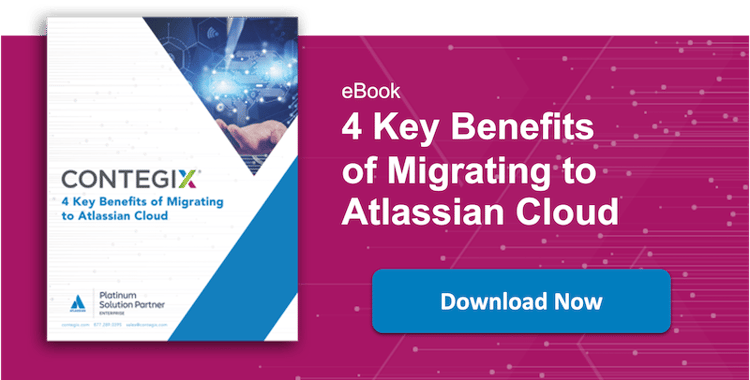For the majority of companies, innovation is happening in the cloud, whether that means launching a new product or making critical updates to existing features. However, out of the 75% of global tech leaders that confirm this strategy, only 8% say they have experience working with cloud-related tools. For organizations to be successful in moving operations into brand new territory—especially as Atlassian rolls out new application features exclusively on cloud—partnering with a team of experts can be an effective way to make the transition and benefit from updated functionality, improved security, and streamlined interfaces immediately.
A migration is a big undertaking for any organization, and that’s especially true for teams that juggle limited resources or are constrained by budgets that prevent them from strengthening their employees’ cloud-based skills. An Atlassian Platinum Solutions Partner like Contegix provides educational support across all phases of migration, while also shouldering the migration tasks to keep projects on time and within budget. This way, organizations don’t have to duplicate their resources or dedicate their own personnel toward the project, and because employees aren’t balancing more than their existing workload, there’s additional time and space for learning, testing, failure, and reconfiguration. The end result? A successful, efficient operating system on the cloud—and an informed team.
Mike Brown, Senior Vice President of Professional Services at Contegix, answers a few key questions about migrating to Atlassian Cloud and how a partner like Contegix can ensure any migration is a success.
Q: Why might organizations be hesitant to migrate to the cloud?
Brown: A migration can be a lengthy process—it’s an investment of several months of time and resources. Plus, it’s a new product for teams to familiarize themselves with. Once the migration is complete, it takes additional time for users to learn new functionality and comfortably work in new interfaces. The key to overcoming this hesitation is a robust planning phase so each step of the process is clear, supported by constant communication to keep everything from feeling too overwhelming. For example, Contegix defines thorough implementation plans for all migrations as part of a six-step process, and also offers training touchpoints to help ease users into cloud products.
Q: What is the most important thing for organizations to understand before beginning a cloud migration?
Brown: At Contegix, the planning phase allows us to outline what unique configurations organizations need to replicate their workflows in the cloud. Sometimes this requires us to create a customized solution, so building in that time in the beginning is necessary for an efficient migration process. Before we start moving customers’ data, we closely review their current environments to understand existing configurations, add-ons, and security requirements. We always prepare a migration strategy centered on organization-specific goals, and if any changes are necessary—such as retiring overly complex workflows or deleting unnecessary data—we share the impacts with all stakeholders to ensure we’re aligned before we do any of the clean-up.
Q: How can migrations incorporate custom solutions that organizations need to ensure all workflows and capabilities meet team needs?
Brown: Every organization has different specific needs from a cloud migration to make sure their tools are supporting their larger goals. For some teams, that might look like better collaboration between departments. For others, it’s better reporting capabilities, which requires us to understand what data needs to inform reports before getting started. With that information, a partner like Contegix can reconfigure the cloud environment to accommodate dashboards that support custom reporting needs.
Q: How can migrations help organizations improve security?
Brown: Simply moving to Atlassian Cloud helps ensure security with its built-in features like automated security upgrades. Plus, common vulnerabilities and exposures (CVEs) are automatically detected and raised to Atlassian teams for resolution. Having a partner during the migration process can also help avoid misconfigurations, which are one of the biggest cloud security challenges.
To learn more about the specific ways that a cloud migration can help streamlining operations, boost security, and more, download our ebook: 4 Key Benefits of Migrating to Atlassian Cloud.

